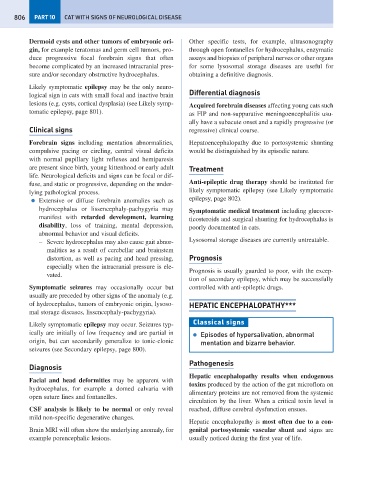Page 814 - Problem-Based Feline Medicine
P. 814
806 PART 10 CAT WITH SIGNS OF NEUROLOGICAL DISEASE
Dermoid cysts and other tumors of embryonic ori- Other specific tests, for example, ultrasonography
gin, for example teratomas and germ cell tumors, pro- through open fontanelles for hydrocephalus, enzymatic
duce progressive focal forebrain signs that often assays and biopsies of peripheral nerves or other organs
become complicated by an increased intracranial pres- for some lysosomal storage diseases are useful for
sure and/or secondary obstructive hydrocephalus. obtaining a definitive diagnosis.
Likely symptomatic epilepsy may be the only neuro-
Differential diagnosis
logical sign in cats with small focal and inactive brain
lesions (e.g. cysts, cortical dysplasia) (see Likely symp- Acquired forebrain diseases affecting young cats such
tomatic epilepsy, page 801). as FIP and non-suppurative meningoencephalitis usu-
ally have a subacute onset and a rapidly progressive (or
Clinical signs regressive) clinical course.
Forebrain signs including mentation abnormalities, Hepatoencephalopathy due to portosystemic shunting
compulsive pacing or circling, central visual deficits would be distinguished by its episodic nature.
with normal pupillary light reflexes and hemiparesis
are present since birth, young kittenhood or early adult Treatment
life. Neurological deficits and signs can be focal or dif-
fuse, and static or progressive, depending on the under- Anti-epileptic drug therapy should be instituted for
lying pathological process. likely symptomatic epilepsy (see Likely symptomatic
● Extensive or diffuse forebrain anomalies such as epilepsy, page 802).
hydrocephalus or lissencephaly-pachygyria may Symptomatic medical treatment including glucocor-
manifest with retarded development, learning ticosteroids and surgical shunting for hydrocephalus is
disability, loss of training, mental depression, poorly documented in cats.
abnormal behavior and visual deficits.
– Severe hydrocephalus may also cause gait abnor- Lysosomal storage diseases are currently untreatable.
malities as a result of cerebellar and brainstem
distortion, as well as pacing and head pressing, Prognosis
especially when the intracranial pressure is ele-
Prognosis is usually guarded to poor, with the excep-
vated.
tion of secondary epilepsy, which may be successfully
Symptomatic seizures may occasionally occur but controlled with anti-epileptic drugs.
usually are preceded by other signs of the anomaly (e.g.
of hydrocephalus, tumors of embryonic origin, lysoso- HEPATIC ENCEPHALOPATHY***
mal storage diseases, lissencephaly-pachygyria).
Classical signs
Likely symptomatic epilepsy may occur. Seizures typ-
ically are initially of low frequency and are partial in ● Episodes of hypersalivation, abnormal
origin, but can secondarily generalize to tonic-clonic mentation and bizarre behavior.
seizures (see Secondary epilepsy, page 800).
Pathogenesis
Diagnosis
Hepatic encephalopathy results when endogenous
Facial and head deformities may be apparent with
toxins produced by the action of the gut microflora on
hydrocephalus, for example a domed calvaria with
alimentary proteins are not removed from the systemic
open suture lines and fontanelles.
circulation by the liver. When a critical toxin level is
CSF analysis is likely to be normal or only reveal reached, diffuse cerebral dysfunction ensues.
mild non-specific degenerative changes.
Hepatic encephalopathy is most often due to a con-
Brain MRI will often show the underlying anomaly, for genital portosystemic vascular shunt and signs are
example porencephalic lesions. usually noticed during the first year of life.

